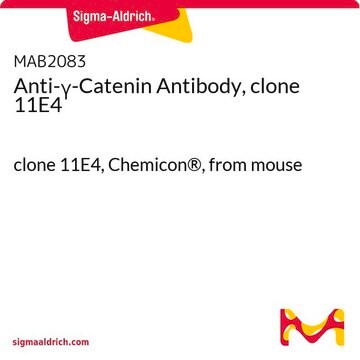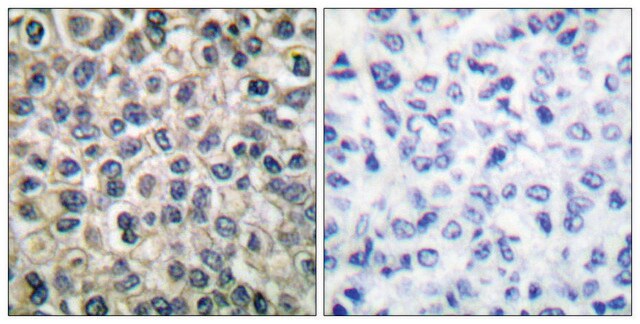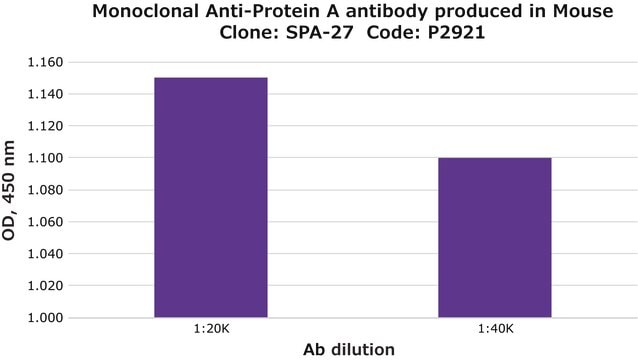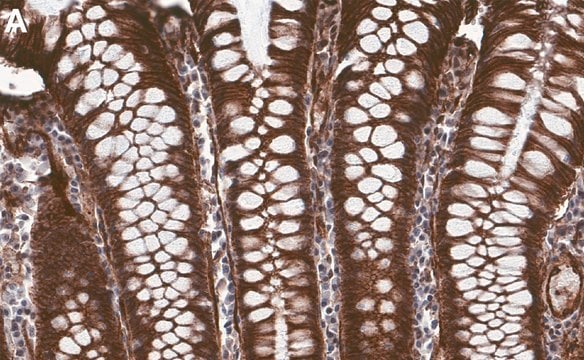추천 제품
생물학적 소스
mouse
Quality Level
결합
unconjugated
항체 형태
ascites fluid
항체 생산 유형
primary antibodies
클론
15F11, monoclonal
양식
buffered aqueous solution
분자량
antigen 85 kDa
포함
15 mM sodium azide
종 반응성
bovine, canine, human
기술
immunocytochemistry: suitable using cultured cells
immunohistochemistry (frozen sections): suitable
immunoprecipitation (IP): suitable
indirect immunofluorescence: 1:1,000 using cultured MDBK cells
microarray: suitable
western blot: 1:2,000 using cultured MDBK cells
동형
IgG1
UniProt 수납 번호
배송 상태
dry ice
저장 온도
−20°C
타겟 번역 후 변형
unmodified
유전자 정보
human ... JUP(3728)
일반 설명
Plakoglobin is a desmosomal protein that regulates developmental signalling in vertebrates. Tyrosine phosphorylation of plakoglobin has been linked to adenocarcinomas . Plakoglobin may function as a tumor suppressor in ovarian and breast cancers .
특이성
The antibody recognizes the plakoglobin (catenin-γ) molecule (85 kDa and possibly a slightly lower band) by immunoblotting. It does not cross-react with β-catenin. The antibody reacts with plakoglobin in bovines, humans and dogs, but does not react with β catenin.
면역원
recombinant chicken plakoglobin.
애플리케이션
Monoclonal anti-plakoglobin (catenin γ) antibody is suitable for use in immunocytochemistry (using MDCK cells), immunoprecipitation, and in immunoblotting . The antibody may also be used for immunohistochemistry (frozen sections), microarray, western blot (1:500, using cultured MDBK cells) and indirect immunofluorescence (1:1000, using cultured MDBK cells).
면책조항
Unless otherwise stated in our catalog or other company documentation accompanying the product(s), our products are intended for research use only and are not to be used for any other purpose, which includes but is not limited to, unauthorized commercial uses, in vitro diagnostic uses, ex vivo or in vivo therapeutic uses or any type of consumption or application to humans or animals.
적합한 제품을 찾을 수 없으신가요?
당사의 제품 선택기 도구.을(를) 시도해 보세요.
Storage Class Code
10 - Combustible liquids
WGK
nwg
Flash Point (°F)
Not applicable
Flash Point (°C)
Not applicable
가장 최신 버전 중 하나를 선택하세요:
시험 성적서(COA)
Lot/Batch Number
S Shibamoto et al.
Cell adhesion and communication, 1(4), 295-305 (1994-01-01)
The effect of hepatocyte growth factor/scatter factor (HGF/SF) and epidermal growth factor (EGF) on cadherin-mediated adhesion of human carcinoma cells was studied. HGF/SF induced scattering of colonic adenocarcinoma HT29 and gastric adenocarcinomas MKN7 and MKN74 cells. Likewise, EGF induced scattering
Iris Wu et al.
Communications medicine, 4(1), 38-38 (2024-03-19)
Arrhythmogenic right ventricular cardiomyopathy (ARVC) is a familial cardiac disease associated with ventricular arrhythmias and an increased risk of sudden cardiac death. Currently, there are no approved treatments that address the underlying genetic cause of this disease, representing a significant
Zhilun Li et al.
Molecular biology of the cell, 21(19), 3317-3329 (2010-08-20)
Cell-to-extracellular matrix adhesion is regulated by a multitude of pathways initiated distally to the core cell-matrix adhesion machinery, such as via growth factor signaling. In contrast to these extrinsically sourced pathways, we now identify a regulatory pathway that is intrinsic
Rene L Begay et al.
JACC. Clinical electrophysiology, 4(4), 504-514 (2018-08-02)
The purpose of this study was to assess the phenotype of Filamin C (FLNC) truncating variants in dilated cardiomyopathy (DCM) and understand the mechanism leading to an arrhythmogenic phenotype. Mutations in FLNC are known to lead to skeletal myopathies, which
H Aberle et al.
Proceedings of the National Academy of Sciences of the United States of America, 92(14), 6384-6388 (1995-07-03)
The gene encoding human plakoglobin was mapped to chromosome 17q12-q22. An intragenic restriction fragment length polymorphism was used to localize the plakoglobin gene distal to locus KRT10 and proximal to the marker D17S858. The plakoglobin gene colocalizes with the polymorphic
자사의 과학자팀은 생명 과학, 재료 과학, 화학 합성, 크로마토그래피, 분석 및 기타 많은 영역을 포함한 모든 과학 분야에 경험이 있습니다..
고객지원팀으로 연락바랍니다.








